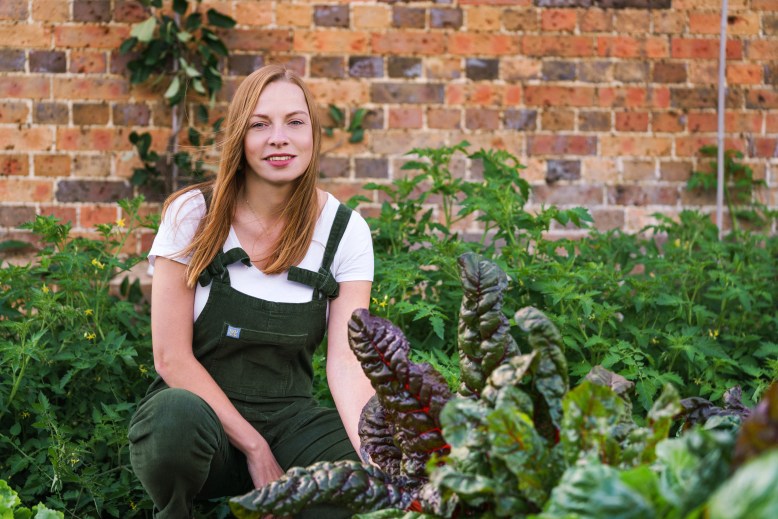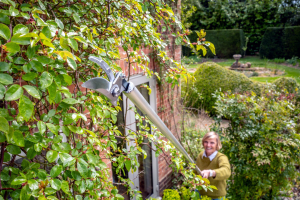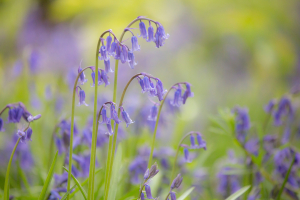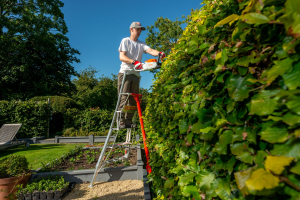How to Grow Your Own Veg: Planting a Veg Garden with Annabelle Padwick

Growing your own veg is an enjoyable and rewarding project to work on throughout the year. It’s something you can do either on your own, with friends and family or as a community project. There are numerous benefits of growing your own vegetables, from mental health, diet, and the fact it’s healthier and cheaper than buying your veg at the supermarket!
We’ve teamed up with Life at No.27’s Annabelle Padwick to put together this vegetable growing guide, so you can get started on your own plot and find out more about the benefits of growing produce.
The Benefits of Growing Your Own Vegetables
There are so many benefits around growing your own vegetables, both for yourself and the environment. Let’s start with the obvious.
Growing your own veg will likely increase your 5-a-day, and they’ll taste better, too. The veg you buy from the supermarket usually travels for weeks across the country, meaning that they lose their nutrients over time. Growing produce in your own vegetable plot gives you more control over the type of food you eat and, more importantly, its nutritional value.
You’ll also be helping the environment when you grow vegetables. There’s no packaging your food in plastic, and you’re reducing carbon emissions as your vegetables aren’t travelling for miles before reaching your plate. By minimising the carbon emissions you’ll be helping make a difference towards our planet - and you’ll feel much better about your diet as well.
The Mental Health Benefits of Growing Your Own Food
It doesn’t stop there. Looking after your own vegetable patch can also do wonders for your mental health.
We all know that gardening can be rewarding. Whether you’re simply eating food that you grew yourself or watching a landscaping project come to life, there’s a sense of gratification that comes from admiring something you’ve been working on for a while. And, if your loved ones have been involved, you get to see something you’ve created come together, building a sense of community and purpose.
Other reasons to grow veg include getting to spend more time outdoors, reducing stress and encouraging mindfulness. You can read more about the mental health benefits of gardening in our guide.
Annabelle Padwick has seen the benefits of vegetable gardening herself. The gardening projects provided by Life at No.27 are designed to promote confidence and reduce anxiety. By getting outdoors and looking after your own simple vegetable garden, you gain a sense of achievement as you watch your veggies thrive. Annabelle has compiled her vegetable growing knowledge in her book, You CAN Grow Your Own Veg, but she’s also given us some of her best tips for our very own guide. Keep reading to find out more.
“Learning to grow your own food can be incredibly rewarding. You sow this tiny inconspicuous seed, you nurture it with the exact same things you need to thrive and then with a bit of patience and love, you can harvest the most delicious fruit and vegetables whilst feeling super proud of yourself!
“You’ll also gain a much greater appreciation for patience and a boost to your resilience levels. This is because not everything will be a success, and that’s ok -we just try again! Plus, we haven’t even touched on the benefits of just being outside in the fresh air, physically moving, gently increasing your heart rate and releasing all those happy endorphins!”
Planning a Vegetable Garden Layout
Now that we’ve explored the benefits, let’s look at planning a vegetable garden. Preparing your patch is an important step when growing vegetables to ensure an impressive harvest, whether you’re starting in your garden, with a small allotment or starting a community garden.
There’s a few things you need to consider when planning your vegetable garden layout:
- Firstly, you need a lot with enough room for your plants to grow. You don’t need a huge space to grow veg, but you don’t want to crowd your plot too much.
- While planning your vegetable garden spacing, keep in mind that different veg require different amounts of space to grow. So it’s best to have an idea of what you’d like to plant before you start. If planting seeds, check the packet for spacing recommendations.
- A general rule is to add together the amount of recommended row spacing for each veg type, and then divide this total by two.
- You’ll rotate your veg as it grows so all plants can experience new ground. Make sure your plot has enough space to rotate.
- The allotment needs a good amount of sunlight - ideally, at least six hours a day. And remember, some veg types require more sun and warmth than others, such as tomatoes and courgettes. If your garden is shaded by trees or hedges, then you might need to cut one or two back using a sturdy ladder, such as our Tripod or Hi-Step.
- You’ll also need the right type of soil. Often, gardens do not have the best soil for growing vegetables. But no need to worry - you can adapt your soil by adding organic matter (vegetable peelings, grass cuttings and manure) and mineral solids, like sand and clay. You should also test its pH level - the RHS has more information on this here.
- Once you have the best garden soil for vegetables, make sure that it is clear of debris before spreading out on the ground. You can transport any soil or compost safely using our Henchman wheelbarrow, to minimise any strain on your arms and back.
“When it comes to planning your layout and seed choices, my biggest tip is to pick the vegetable seeds or plants that you know you will love to eat. Why? Because you will want them to succeed more than a vegetable you aren’t so fussed about, or really dislike.
“Plus, why take up precious space in your garden with plants that don’t benefit you in any way? Every plant in your garden, whether it’s a tree, vegetable, flower, fruit or hedgerow, should serve a purpose in improving and benefiting your overall wellbeing, whether it’s the look of it that makes you smile, the taste or smell that lifts your spirits, the sound or even the feel of it that helps you feel calm”.
When to Grow Vegetables
When deciding which vegetables to grow, you should also consider the time of year to sow and harvest. In order to harvest your veg at their peak time when they taste their best, you’ll need to sow at the right time.
There will be vegetables you can plant most months of the year. The RHS has a seasonality guide over on their website, but we’ve made a quick seasonal vegetable planting guide below:
Growing veg in Spring:
- Onions can be grown from either sets or seeds, ready for harvesting in summer. You can also plant peas and beans.
- Crops of leafy vegetables such as lettuce, chard and spinach can be planted throughout Spring. Leeks and carrots, and cauliflower can also be grown.
- Spring is the best time to plant herbs, although they can be planted throughout the year, as long as the ground isn’t frozen.
Growing veg in Summer:
- Cucumbers, fennel and peas can be planted early in the season.
- Small batches of radishes can be planted regularly and harvested in as little as four weeks.
- Spring onions can be sown in late summer, ready to harvest in early Autumn.
- You can also plant carrots and beetroot from March to July.
Growing veg in Autumn:
- Plant rocket and spinach in early September.
- Garlic can be planted later in the season.
- If the weather is milder, you can plant broad beans in late Autumn, instead of waiting for winter.
- Rhubarb can also be planted between Autumn and Spring.
Growing veg in Winter:
- If the weather is mild, you can plant garlic again during winter.
- Asparagus, broad beans, spinach and kale can grow in cold temperatures.
- Onions and shallots can also be grown throughout the season.
It’s also worth noting that you can sow some vegetable seeds, such as broccoli, brussel sprouts, kale and cauliflower, in pots or seed trays at the start of the year, and then plant outside during the summer months.
If you’re unsure where to start, there are plenty of easy veggies to grow. Potatoes, onions, runner beans, tomatoes are just some simple and low maintenance vegetables that you can start with.
“Slow and steady wins the race -that’s my motto with seed sowing! We are all itching to get sowing as soon as the first daffodil starts flowering, or perhaps even the first snowdrop, but there is no rush. If we sow too early, the chance of having weak, leggy plants which could get killed by a surprise frost increases. If you start sowing later, they will nearly always catch up once the summer sunny days start arriving. Take your time and sow each seed with care.
“On a boring but very important note, read the instructions on the seed packet. They are usually pretty accurate and will give you the best chance of success. Sowing each seed individually will mean you have less work to do later, no thinning out, and less chance of overcrowded plants. The physical process of sowing each seed will relax you, too”.
Vegetable Planting Guide
Now that you’ve decided what you’re planting and when, and you’ve prepped the space, it’s time to get started.
If you’re planting with seeds, you can start either indoors or outdoors. When sowing outside, sprinkle the seeds directly in the soil, into shallow funnels with water. Always read the packet instructions for more planting information.
Thanks to your vegetable garden planning, you may already have an idea of what should be planted where. If you’re unsure, then plant tall plants north or west of your plot, medium-sized veg in the middle, and shorter veg at the bottom.
Once you’ve planted your vegetables, apply mulch to the soil to prevent it from drying out and warming up. This can be quite messy, so it's a good idea to wear gardening gloves while doing this - especially in colder weather!
How to Care for a Vegetable Garden
Once you’ve finished planting your vegetable garden, there’s still a few things you can do throughout the year to help your vegetables thrive:
- Water your plants regularly.
- Add organic matter to the soil once or twice a year after planting.
- If you haven’t already, tressile your veg plants as they grow.
- Remove weeds as and when you need to.
- Watch out for pests. Slugs, caterpillars and aphids can eat their way through your leaves or suck out the sap from your plants, weakening growth. Simply move the creatures far away from your vegetable garden, or, in the case of aphids, spray them with water.
- You can also add companion plants near your vegetables, as these deter certain pests. Marigolds and chives keep aphids away from beans.
- Remove fragile or dead stems and leaves as often as you need. It’s important that you maintain space in your vegetable garden to avoid stunting veg growth.
“If you ever get stuck on how to look after your growing vegetables, think about what you need to grow and re-check the seed packet. Are they getting enough sunlight, water, space, air and food? Many plants, such as tomatoes, chillies and other flowering produce, need a weekly or fortnightly dose of plant feed added to the watering can once they start growing in the ground and flowering.
“My final tip is about watering. Use your finger to check if your plants and the soil need watering. Don’t just look at the surface. Poke your finger down into the soil and, if it still feels wet, leave them alone. If it feels dry, give the soil some water. Always water around the base of the plant and not over the top, if you can. This helps reduce diseases and makes sure that the water is reaching those precious, thirsty roots.”
Grow Your Own Veg with Henchman
Growing your own veg is a fun project for gardeners of all ages and experience to get involved with. Nothing beats the feeling of picking vegetables from your own garden and seeing how well they’ve grown.
As Annabelle mentioned early in this guide, growing your own fruit and veg can benefit your mental health in so many ways. It’s also great for your physical health, as well as cultivating relationships with your friends and family.
At Henchman, we have the tools you need to create the perfect garden, whether you’re growing vegetables at home or at a community lot or having a tidy up for spring. Explore our range of gardening accessories and high-quality ladders here.
If you’d like to get the whole family involved and start growing food at home, then take a look at Annabelle’s book, You CAN Grow Your Own Veg.



